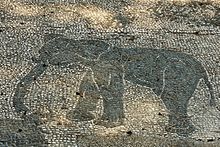Our website is made possible by displaying online advertisements to our visitors.
Please consider supporting us by disabling your ad blocker.
North African elephant
| North African elephant Temporal range: Holocene
| |
|---|---|

| |
| Roman mosaic at Ostia Antica, Italy | |
| Scientific classification | |
| Domain: | Eukaryota |
| Kingdom: | Animalia |
| Phylum: | Chordata |
| Class: | Mammalia |
| Order: | Proboscidea |
| Family: | Elephantidae |
| Genus: | Loxodonta |
| Species: | |
| Subspecies: | †L. a. pharaoensis
|
| Trinomial name | |
| †Loxodonta africana pharaoensis Deraniyagala, 1948
| |
| Synonyms | |
The North African elephant (Loxodonta africana pharaohensis) is an extinct subspecies of the African bush elephant (Loxodonta africana), or possibly a separate elephant species, that existed in North Africa, north of the Sahara, until it died out in Roman times. These were the famous war elephants used by Carthage in the Punic Wars, their conflict with the Roman Republic. Although the subspecies has been formally described,[3][4] it has not been widely recognized by taxonomists.[2][5] Other names for this animal include the North African forest elephant,[6][7] Carthaginian elephant,[5][8] and Atlas elephant.[citation needed] Its natural range probably extended along the coast of the Red Sea, in what is now Egypt, Sudan, and Eritrea,[7][5] but it may have extended further across northern Africa.[9]
- ^ Pritisk, Yuri (November 2019). "North African or Carthaginian elephant (Loxodonta africana pharaohensis)". Smithsonian Magazine. Retrieved 5 January 2023.
- ^ a b c Shoshani, J. (2005). "Order Proboscidea". In Wilson, D.E.; Reeder, D.M (eds.). Mammal Species of the World: A Taxonomic and Geographic Reference (3rd ed.). Johns Hopkins University Press. p. 91. ISBN 978-0-8018-8221-0. OCLC 62265494.
- ^ Nowak, Ronald M. (1999). Walker's Mammals of the World (6 ed.). Baltimore: Johns Hopkins University Press. p. 1002. ISBN 978-0-8018-5789-8.
- ^ Yalden, D. W.; Largen, M. J.; Kock, D. (1986). "Catalogue of the Mammals of Ethiopia (III: Order Proboscidea)". Monitore Zoologico Italiano, Supplemento. 21 (1): 46–52. doi:10.1080/03749444.1986.10736707.
- ^ a b c Charles, Michael B. (December 2020). "The African Elephants of Antiquity Revisited: Habitat and Representational Evidence". Historia. 69 (4): 392–407. doi:10.25162/historia-2020-0017.
- ^ O'bryhim, S. (May 1991). "Hannibal's Elephants and the Crossing of the Rhône". The Classical Quarterly. 41 (1): 121–125. doi:10.1017/S0009838800003591.
- ^ a b Lobban Jr., Richard A.; de Liedekerke, Valerie (2000). "Elephants in Ancient Egypt and Nubia". Anthrozoös. 13 (4): 232–244. doi:10.2752/089279300786999707.
- ^ Jones, Brynmor (May 1938). "Desiccation and the West African Colonies". The Geographical Journal. 91 (5): 401–423.
- ^ Cite error: The named reference
mswas invoked but never defined (see the help page).
Previous Page Next Page


